Redness, peeling of the skin on the legs, the appearance of cracks between the fingers, ulcers on the feet, a change in the condition of the nails: loss of shine, the usual pinkish shade, thickening of the plates - these and other signs indicate the development of a fungal infection. Every fifth resident of the Earth is sick with mycosis. Therefore, you need to know how the fungus looks and behaves on the legs, what causes lead to its appearance and how to treat this unpleasant disease.
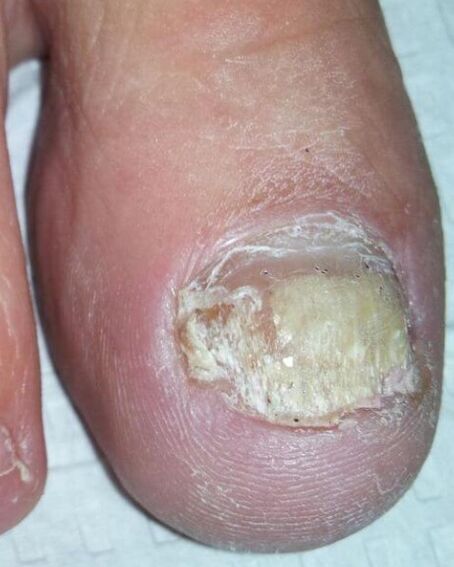
Reasons
In most cases, infection of mycosis comes from a person to a person directly or through the surrounding objects. Favorable conditions for the reproduction of the fungus are fever, humidity. Disputes can also maintain viability in a dried state, after poor -quality processing of manicure tools.
The main reasons for the disease include:
- Lack of regular feet care.
- Accommodation with a person suffering from a fungus.
- Using someone else's shoes, socks.
- Stop injuries.
- Visiting "mushroom" common areas (beaches, baths, pools).
- Insufficient processing of accessories for pedicure.
- Wearing tight shoes from synthetic materials.
- Professional harmfulness (work in conditions of high temperature and humidity).
- Firing shoes in a store without a sock or a detachment.
Fungal diseases in humans develop faster against the background of the features of functioning, as well as changes leading to the suppression of immunity, impaired local circulatory, changes in the condition of the skin. The reasons from the body are as follows:
- endocrine pathology (diabetes, obesity);
- pregnancy;
- immunodeficiency states;
- increased sweating;
- foot diseases;
- vascular disorders;
- chronic skin diseases (eczema, psoriasis);
- Long -term intake of drugs that suppress immunity (corticosteroids, cytostatics).
Types of pathogenic mushrooms
Mushrooms on the human body feed on proteins - keratin, elastin, collagen, splitting them with enzymes: keratinase. The localization of mycosis depends on the activity of keratinase and the ability to digest different types of keratin.
Mycoses on the legs cause the following types of fungus:
- Trichophyton Rubrum-a type of fungi-saprophytes inhabiting a keratinized layer of skin. Causes cutting lichen, damage to the epidermis, nails in 80 % of cases.
- Trichophyton Mentagraphytes causes Stop epidermophytius.
- Trichophyton Interdigitale. On the legs, the fungus causes dermatophytosis, onychomycosis.
- Mushrooms of the genus Candida affect the skin and nail plates with a severe decrease in immunity affect the skin and nail plates with a severe decrease in immunity.
Fungal skin lesions
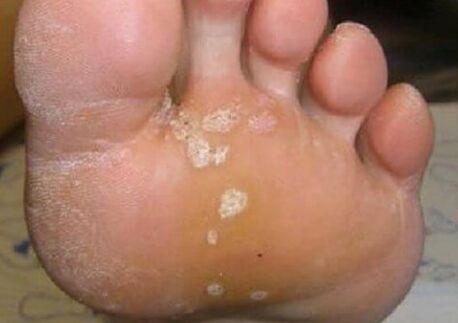
From mycosis on the legs, lesion of the skin during psoriasis (sometimes it is called a dry fungus) - red plaques with peeling and a tendency to merger rising above the surface. Such elements are often found on the knees, legs. This disease is not associated with a fungal infection.
The manifestations of the fungus of the foot are conditionally divided into four main forms. Convention is in a combination of clinical signs and the possibility of transition from one to another.
In intertriginous form, the skin is suffered in interdigital spaces. The fungus of the skin of the legs manifests itself in the form of itching, burning, it is accompanied by an unpleasant odor. Often the infection affects the foot from the intervals between 3 and 4, 4 and 5 fingers. The skin turns red, impregnated with moisture, sores, weeping areas appear between the fingers. These signs develop independently or against the background of an existing squamous form.
Note! For intertriginous lesion typical, the attachment of a secondary bacterial infection that exacerbates the disease. Bacterial, mycotic eczema develops with the formation of a rash not only on the foot, inflammatory elements appear on the ankle, lowering.
The advanced squamous-hyperkeratotic form looks like common, massive corns on the sole with cracks. Initially, mycosis of the skin of the legs can attract attention with dryness, peeling of the skin of the feet, limited rough corn on the heels. People consider such symptoms an individual feature and do not turn to a dermatologist. Skin lesions can accompany itching, burning. If you look at the photos of the fungus on the legs with this form of mycosis, you can notice deep cracks against the background of a thickened (and, as it were, shod in moccasins) of the skin of the feet. Such manifestations are painful. The squamous form is characterized by the involvement of nail plates with their destruction, a lag behind the nail bed.
The manifestations of the dyshidrotic (vesicular) shape of the foot fungus are infrequent. The main symptom of the disease is the formation of bubbles with a thick shell and transparent contents. They are localized on the sole side of the foot, the fingers as single or drain formations. Then the bubbles are opened with the formation of erosion with purulent crusts around the edges. Complications of vesicular lesion include:
- Toxic-allergic reactions. They develop for 4-6 days, often localized symmetrically: swollen reddish papules can be found on the foot, lower leg, forearm, face, mucous membranes.
- Connection of a secondary bacterial or viral infection with the development of eczema.
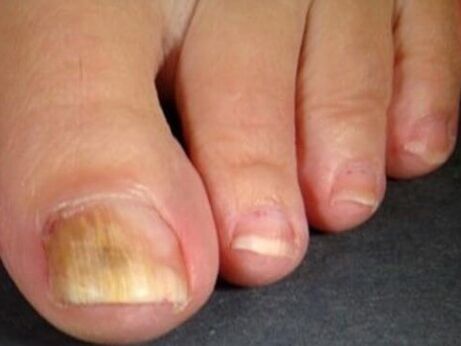
The erased shape of the fungus on the feet is characterized by minimal lesions, so it is not easy to recognize it. The main signs: the appearance of bowelous peeling, the formation of microcracks between the fingers, discomfort, burning. With a long course, the nail plates are involved.
Nail fungus
Onychomycosis appears as a result of the skin fungus on the fingers, feet, in the absence of attention to the problem and adequate treatment.
The first symptoms and signs of onychomycosis can also go unnoticed. You should contact the nail fungus on the legs and contact a dermatologist at:
- change in the color of the nail plates;
- the appearance of yellow or grayish spots;
- loss of shine;
- appearance on the surface of irregularities;
- strips in the structure of the nail;
- increased brittleness.
There are various classifications of onychomycosis. By the appearance of the nail plate, they are divided into:
- Normotrophic. The fungal infection changes the color of the nails to yellowish-gray, the thickness and shape remain the same.
- Hypertrophic. This type of fungus is characterized by gross changes: the nails turn yellow, thicken. If you look at the photos depicting this type of onychomycosis, you can notice a characteristic coracible shape of the plates. Transverse studies, loosening and brittleness in the free edge are visible. Such a change in nails leads to their growing. Walking becomes painful.
- Onycholithic. The nail plates become thinner, change color, exfoliate from the nail bed.
According to the localization and degree of damage to the nail plate, the following types of onychomycosis are distinguished: distal; lateral; mixed, proximal; total; surface.
Candidiasis defeat
Separately, the damage to the mushrooms of the genus Candida should be considered. These conditionally pathogenic mushrooms cause deep (affecting internal organs) and surface mycoses (dermatomycosis, onychomycosis). Under normal conditions, human immunity suppresses the reproduction of this fungus and a massive infection does not occur. Therefore, the activity of candida is manifested with significant disorders in the body of protecting the body and requires a thorough examination to establish the cause of immunodeficiency. The first signs of infection are difficult to distinguish from injury, frostbite.
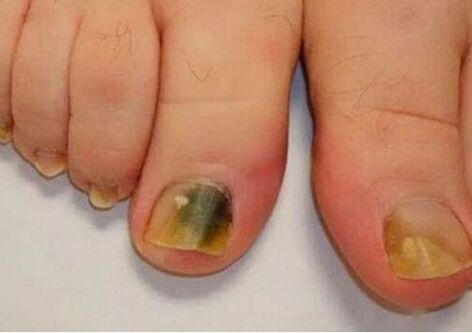
The fungal damage to the legs develops as follows:
- On the fingers of the legs there is an inflammation of the nail rollers with redness, swelling, cracks on the skin, the appearance of discomfort in any movements. Under the nail plates, a purulent separated whitish shade is formed.
- Inflammatory changes in the skin subside, the disease becomes chronic. The skin around the nail thickens, stops growing. The infection affects the nail plates.
- The nails on the legs begin to thicken, to sprinkle. Their color becomes brown, brown. Violation of blood supply leads to rejection.
Diagnostics
Diagnosis of the fungus on the legs includes:
- Conversation with the patient (complaints, accompanying diseases, working conditions, clarification of the possibility of infection).
- Inspection.
- Laboratory research methods (scraping of the skin, nails with microscopy, sowing of a dedicated crop with determining sensitivity to drugs, IG G to aspergille, candidates).
Treatment
The fungus on the legs requires immediate treatment that a dermatologist (or mycologist) will prescribe. You can perform assignments on an outpatient basis.
How and how to treat the fungus on the legs depends on a number of conditions:
- localization of the pathological process;
- degree, severity of defeat;
- the presence of concomitant diseases;
- patient age;
- In cases of therapy of women - the fact of pregnancy, breastfeeding.
Treatment of the fungus on the legs takes a lot of time and its main goal is the disappearance of clinical and laboratory signs of infection. An incomplete course of therapy leads to relapse of the disease.
Drug therapy
Drug treatment is carried out using antifungal drugs that not only destroy mycosis, but also help remove the manifestations of inflammation and eliminate the secondary infection.
They are divided into:
- Local. Apply to the lesion (ointment, gel, cream, spray, varnish, solution).
- Systemic ones - take orally (tablets, capsules, solutions).
At the initial stage of a fungal infection, drug therapy is limited to the appointment of local funds. With common mycosis, with a severe course, the connection of systemic antimycotics is required.
Treatment with folk remedies.
There are many recommendations on how to get rid of the fungus on the legs of folk and home remedies. Most implies external use, and some - inward. However, you should not drink and apply dubious compositions to your feet in the hope of bringing the neglected mycosis. Such folk methods can harm health.
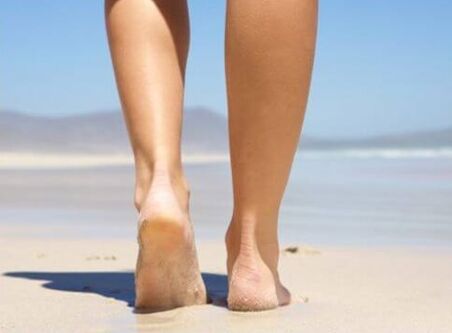
Note! The most common and effective home remedy for fungus is the legs for legs with salt, soda, essential oils. These therapeutic procedures prepare feet and nails for the application of drugs.
Surgical treatment
With a massive fungal damage, the nail plates will have to be removed. This method is safe and practically has no contraindications. An alternative to surgical manipulation - the use of pastes and ointments for softening nails followed by removal.
Laser treatment
The use of a laser to combat onychomycosis is based on heating and destroying the spores of the fungus with a directed beam. This technique allows you to quickly cure onychomycosis, safe and applicable in patients who are contraindicated in systemic treatment.
Treatment of dermatomycosis
To start the treatment of the fungus, local antifungal agents are used on the legs. If after a 2-week course of treatment there is no improvement in the condition, an antimycotic agent is required. In case of severe damage, the skin fungus requires the prescription of systemic drugs. Therapy continues until the complete elimination of the infection.
Treatment of onychomycosis
To eliminate the initial manifestations of nail fungus, local drugs are prescribed. Mycosis with a lesion of more than 2/3 of the area of the nail, involving growth zone, distribution to other plates - an indication for taking systemic drugs. Onychomycosis with massive destruction of the nail plates begin to be treated with surgical removal of the affected tissues of the nail. This method provides access to the focus of infection.
Important!
Treatment of onychomycosis is carried out before the growing of healthy nails and can last up to 12 months.
The appearance of the fungus on the legs can be caused by various reasons. An attentive attitude to your health will help to recognize the disease in time and begin treatment.


























